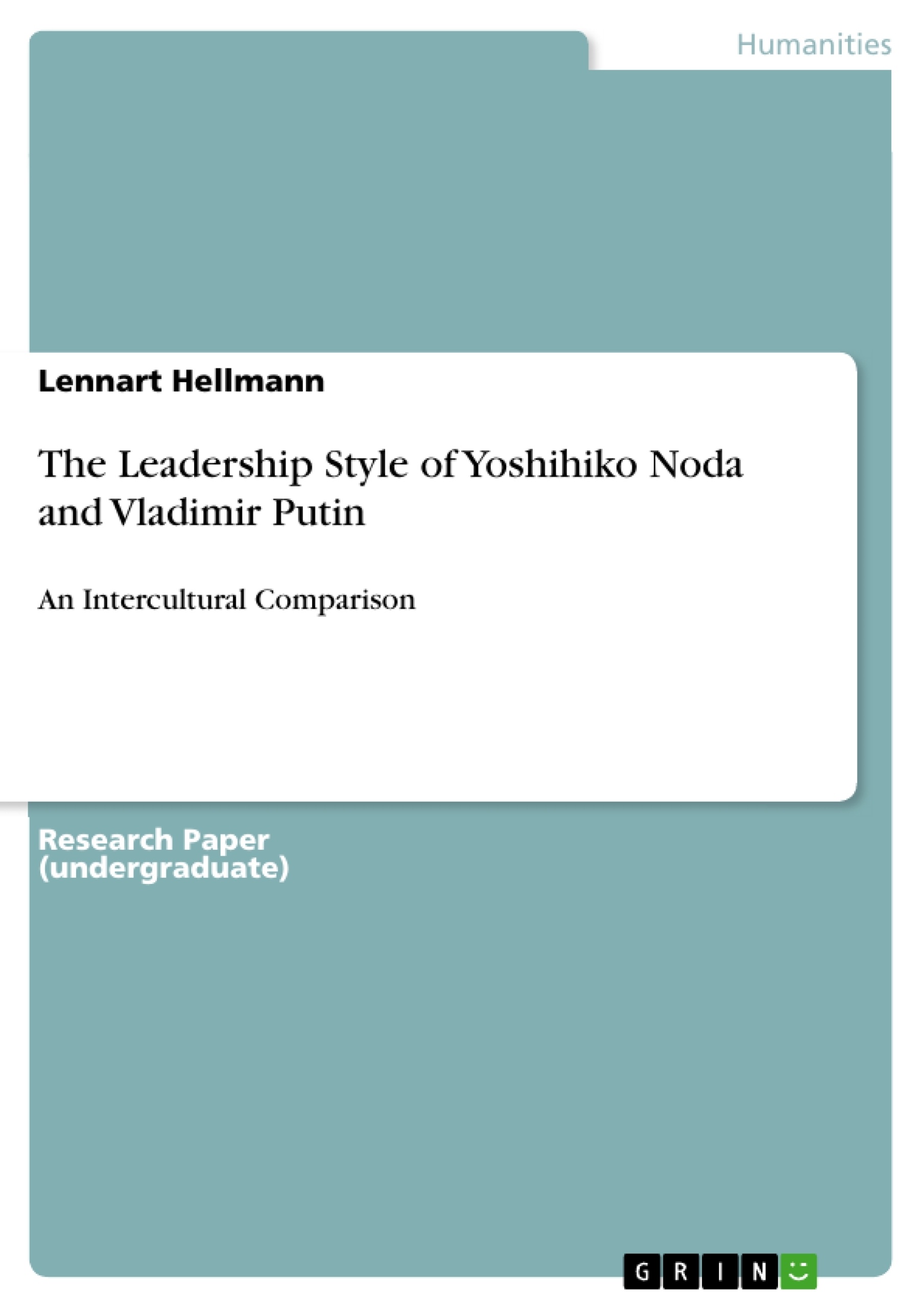The paper "The Leadership Style of Yoshihiko Noda and Vladimir
Putin – An Intercultural Comparison" discusses the impact of different leadership styles in Russia and Japan from a western and asian perspective. It outlines the major theories of leadership studies as well as certain aspects of
intercultural findings.
In the comparison of the two leaders, their background and culture are certain hints that on the one hand culture has and undisputable impact on a leaders behaviour however on the other hand a leader is able to surpass cultural boundaries.
Table of Contents
- I. Introduction
- 1. What is Leadership?
- 2. What is Culture?
- II. Main Body
- 1. Leadership in Japan
- 1.1 Japan, an Introduction
- 1.2 The Leadership Style of Yoshihiko Noda
- 2. Leadership in Russia
- 2.1 The Culture of Russia
- 2.2 The Leadership Style of Vladimir Putin
- 3. A Comparison of Putin's and Noda's Leadership Styles
- III. Conclusion and Forecast
- IV. Bibliography
Objectives and Key Themes
This paper aims to compare the leadership styles of Vladimir Putin and Yoshihiko Noda, contrasting Western and Eastern perspectives on leadership. It examines how cultural context shapes leadership approaches and analyzes the individual leadership styles in relation to their respective national contexts. The analysis considers the impact of cultural factors on leadership effectiveness and explores the differences between centralized and polycentric power systems.
- The definition and theoretical approaches to leadership.
- The cultural dimensions influencing leadership in Japan and Russia.
- A comparative analysis of Putin's and Noda's leadership styles.
- The influence of cultural context on leadership effectiveness.
- The contrasting power structures in Japan and Russia.
Chapter Summaries
I. Introduction: This introductory chapter establishes the context for comparing the leadership styles of Vladimir Putin and Yoshihiko Noda. It highlights the contrasting perceptions of these leaders in Germany, suggesting a fundamental difference in how leadership is perceived in Western and Eastern cultures. The chapter introduces the core concepts of leadership and culture, setting the stage for a deeper exploration in subsequent chapters. It touches upon the complexities of defining leadership and culture, foreshadowing the methodological challenges addressed in later sections.
II. Main Body: This section forms the core of the paper, diving into detailed analyses of leadership in Japan and Russia. It explores the specific leadership styles of Yoshihiko Noda and Vladimir Putin, situating them within their respective cultural and political contexts. The chapter sets the stage for a comparative analysis that will follow, highlighting the key characteristics and contrasting features of each leader's approach.
Keywords
Leadership styles, cross-cultural comparison, Vladimir Putin, Yoshihiko Noda, Japan, Russia, political leadership, cultural dimensions, power distance, centralized vs. polycentric systems, authoritarian leadership, consensus-oriented leadership.
Frequently Asked Questions: A Comparative Analysis of the Leadership Styles of Vladimir Putin and Yoshihiko Noda
What is the main focus of this paper?
This paper conducts a comparative analysis of the leadership styles of Vladimir Putin (Russia) and Yoshihiko Noda (Japan), contrasting Western and Eastern leadership perspectives. It examines how cultural context influences leadership approaches and analyzes their styles within their national contexts. The impact of cultural factors on leadership effectiveness and the differences between centralized and polycentric power systems are also explored.
What are the key themes explored in this paper?
The key themes include: defining and approaching leadership theoretically; cultural dimensions influencing leadership in Japan and Russia; comparative analysis of Putin's and Noda's leadership styles; the influence of cultural context on leadership effectiveness; and contrasting power structures in Japan and Russia.
What is included in the Table of Contents?
The Table of Contents covers: an introduction defining leadership and culture; a main body analyzing leadership in Japan (including Yoshihiko Noda's style) and Russia (including Vladimir Putin's style), and comparing their styles; a conclusion and forecast; and a bibliography.
What are the chapter summaries?
The introduction sets the context for comparing Putin and Noda's leadership styles, highlighting contrasting Western and Eastern perceptions of leadership and introducing core concepts. The main body provides detailed analyses of leadership in Japan and Russia, exploring the styles of Noda and Putin within their cultural and political contexts, setting the stage for a comparative analysis. The conclusion and forecast (and bibliography) are also summarized.
What keywords describe this paper?
Keywords include: Leadership styles, cross-cultural comparison, Vladimir Putin, Yoshihiko Noda, Japan, Russia, political leadership, cultural dimensions, power distance, centralized vs. polycentric systems, authoritarian leadership, consensus-oriented leadership.
What is the overall objective of this research?
The paper aims to compare the leadership styles of Vladimir Putin and Yoshihiko Noda, contrasting Western and Eastern perspectives on leadership. It investigates how culture shapes leadership and analyzes individual styles within national contexts, considering the impact of cultural factors on leadership effectiveness and exploring differences in power systems.
What specific aspects of leadership are compared?
The comparison focuses on the leadership styles of Putin and Noda, analyzing how their approaches are shaped by their respective cultural and political contexts. It highlights the differences between centralized and more consensus-oriented leadership approaches.
- Quote paper
- Lennart Hellmann (Author), 2013, The Leadership Style of Yoshihiko Noda and Vladimir Putin , Munich, GRIN Verlag, https://www.grin.com/document/229871



